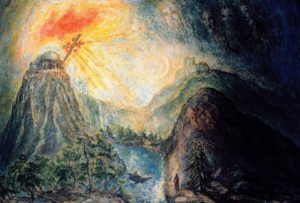24 Nov From the World Society On Uncommon Ground by Bert Chase, General Secretary
Dear Members and Friends of the Anthroposophical Society in Canada,
Every morning each of us enacts a remarkable ritual. We turn back our bedding, place our feet on the floor beside our bed, and stand to face the day. What we do not recognize is that this simple, yet significant process, is based on unrecognized expectations. We expect that the ground beneath our feet will support us. We expect that the relationships we had when we went to sleep will be there to meet us; our tasks in the world will remain unchanged. We trust the garment that gives our lives meaning will be there waiting for us, that we can put it on and, with it, have our orientation to a new day.
Every day, whether we are conscious of it or not, each of us seeks for the firm ground of what has been. We look back over this year 2020 and, from the vantage point of a little distance, find ourselves uncomfortable, startled. A sense of vertigo comes and, with it, a deep unease. All that has supported us is no longer as it has been. We can observe how, in stages, our ground has shifted, continues to move. In the early months of the year we felt secure. We looked ‘there’ where, from a seemingly safe vantage point, we saw disorder entering human society. The distance soon disappeared and we found these islands of disintegrating social fabric appearing throughout our world – no longer there, but here. But this was in the spring and, despite all of the difficulties facing humanity, the awakening earth gave us assurance that the unease would pass with the season. Summer arrived and with relief we began to have a sense that the edges of ‘normalcy’ were beginning to emerge, providing a sense of the familiar. Yet – a mirage.
As autumn arrived, across the country we began to look for ways of re-establishing our connections with each other. Here and there members groups began to meet again, relieved that we could finally sit together – setting aside the virtual connections that had for a time supported us. On the one hand, we could appreciate that there had been possibilities to carry on our work at ‘safe distances’. We felt we had found new ways of meeting and were ready to now set aside the experiment and return to the familiar. We appreciated the success of our AGM that had made it possible for some to participate in ways that had not been possible before. And yet the sense of something incomplete remains. An ache, a deep sense of separation, the ever-present veil of technology between us.
As winter approaches, the temporary relief that summer had provided is evaporating. On every side, the delicate first steps taken toward meeting together again are increasingly being impinged upon. Once again, we feel ourselves on uncommon ground. Though we find ourselves seeking a return to what is familiar, what has nurtured us, we are faced with the uneasy sense that this ‘return’ may well be a distraction. Are we before a doorway? Is there something new being asked of us that we have not yet perceived? Is the readjustment of our foundations a deep shifting of tectonic plates beneath us, the structures of our shared life seeking to transform themselves?
As we look back 100 years, we can recognize ourselves in what had occurred then. The structures of human societies were disintegrating. Interrelationships, both individual and societal, that had seemed established and firm, crumbled away. New images of ourselves as human beings, as cultures, were being called for.
With reflection, we can recognize within ourselves a deep longing for a ‘new way’, a new way of discerning the hidden patterns of an emerging new reality. It is as if each morning, when we stand to face our days, the expectations of meeting what has been, masks our capacity to discern these arising patterns.
As if in preparation for these ‘points of turning’ that were to come with our current age, Rudolf Steiner provides us with many ways of meeting what would bring about transformation. One of the striking images he gives us – a glyph for our time – is the image of a temple, raised up on high ground. A cross and roses hover before it.
As Rudolf Steiner revealed that the essence of the rose is the closest we can come to the nature, the being, of what the human being would become – will become, this image seems to indicate that this temple and its ‘rose sign’ is one guide for us in our current point of transition. The image was, and still is, huge. It spans the whole of the Goetheanum stage, the image that for 100 years meets those able to attend the Mystery Dramas as they enter the Great Hall.
Is the solid ground upon which the temple stands, that which serves humanity’s becoming? Is what this image rises to reveal with each of the dramas, what gives us a new orientation, new meaning, each new day? Is the consciousness of the community we have chosen before birth, the substance of our former lives, to be the foundation – built life after life – the solid ground given to us now to stand upon? A new centre of gravity.
Can we begin to perceive the incomprehensible significance of the person beside us, the person before us? Can we begin to apprehend that in this mutual recognition we begin to weave the living fabric of life as it can become? In this, can we begin to experience the extraordinary strength of the new ground we long to become conscious of? Are these the foundations of a new way of standing to meet each new day?
With warm regards
Bert Chase
General Secretary for Canada
